Abstract
Latent heat storage materials have been tested by several researchers for decades to be used as passive heating and cooling systems in buildings but their implementation into building components is still stacked as is facing specific technical limitations related to difficulties to be charged both in heating and cooling periods. This paper presents a numerical analysis to evaluate the potential of a disruptive system, which is designed to solve the main drawbacks and to convert phase change materials (PCM) passive heating technology into a competitive solution for the building sector. The novel technology moves PCM layer with respect to the insulation layer inside the building component to maximize solar benefits in winter and be able to actively provide space heating. Design variables such as PCM melting point and control schemes were optimized. The results demonstrated that this technology is not only able to limit heat losses towards outdoors but it can provide space heating from stored solar energy when required. The promising numerical results endorse the possibility to build a future experimental prototype to quantify more in detail the benefits of this system.
1. Introduction
Building envelopes have a crucial impact on building energy use for space heating and cooling systems and their designs are crucial to reduce these loads while maintaining the occupants thermal comfort [1]. Currently, both heating and cooling demands represent 50% of the total global energy consumed in European buildings and this demand is increasing with the comfort requirements in developing countries [2].
Within this context, the use of phase change materials (PCM) for passive heating and cooling systems in buildings has attracted the attention of the scientific community as an appropriate technology which can promote net-zero energy buildings [3]. These materials, when integrated into building walls or roofs, can provide thermal benefits due to its high thermal energy storage capacity, which can prevent or delay the cooling peak load during summer and can absorb part of the solar radiation in winter. In building envelope applications, PCM stores latent heat as the ambient temperature rises to the melting point (most PCM changes from a solid to a liquid state) and as the temperature cools down, the PCM returns to a solid phase, releasing the stored latent heat [4].
Several researchers have investigated and developed different ways to incorporate PCM into building envelopes [5], such as microencapsulated [6,7,8], impregnated [9], or installed in macro-encapsulated panels [10]. Numerical and experimental research have emphasized the benefits of using passive PCM technology in buildings: (1) reduction of maximum room air temperature during the cooling period [11], (2) reduction of thermal oscillation during the cooling period, (3) cooling load reduction [12], and (4) possible solar absorption and heating load reduction [13].
However, there exist specific technical barriers that limit the benefits of both PCM heating and cooling passive technologies and do not allow them to become an attractive technology able to justify their initial economic investment. These technical barriers are blocking the implementation of this technology into the market. In case of PCM passive cooling, the solidification process of PCM is limited as the PCM layer is not directly exposed outdoors but thermally protected by insulation (Figure 1), which makes the technology completely useless in periods when solidification cannot be ensured. Within this context, Mandilaras et al. [14] experimentally tested passive PCM in two-storey buildings and showed that PCM did not provide benefits from July to August (when cooling is highly demanded) as solidification was not achieved during night time. Moreover, in PCM passive cooling applications, the building peak cooling load is accumulated in the PCM and therefore its effect indoors is delayed, however, that latent heat is mainly discharged indoors because the insulation strongly limits its dissipation to outdoors. Finally, passive cooling PCM technology only interferes in outdoor cooling loads transmitted by conduction but it cannot deal with internal heat loads or solar gains from openings. In fact, this technology provides higher energy consumption for space cooling in the presence of significant internal heating loads [15].
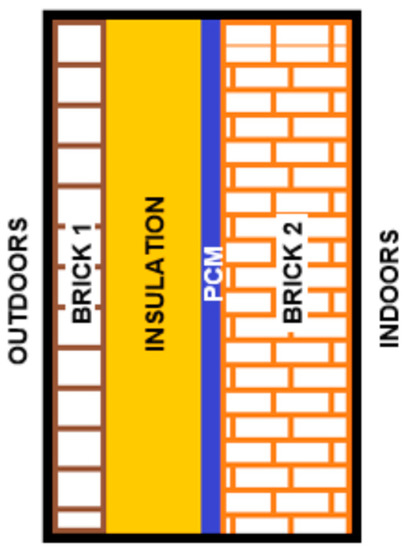
Figure 1.
Implementation of passive phase change materials (PCM) in static building envelope.
On the other hand, the use of PCM for heating purposes is based on its capability to absorb solar gains coming through the glazing and to release stored solar energy during the night [16]. This limited activation conditions limits: (1) its energy benefits (quantified around 4–5% [17]), (2) its implementation mainly to internal solar exposed surfaces (internal walls or floor), and (3) its use in climatic regions with non-severe winter conditions (otherwise, only operative during early and late winter as well as spring and autumn seasons) [13].
The idea behind the system presented in this paper relies on changing the age-old concept that building envelopes are static and fixed during its use. Research has been developed in the frame of developing climatic adaptive building shells (CABS) [18,19,20]. One can imagine that it would provide extraordinary energy benefits if building envelopes (roofs or walls) can modify its thermal properties, such as thermal resistance or heat storage capacity, according to the heating and cooling demand daily profiles.
For example, it will be interesting to remove the insulating layers of building envelopes (roofs and walls) in an office building during summer nights so the building can dissipate the heat stored from external and internal loads to outdoors. However, insulation is required to prevent peak cooling load during the day. Similarly, in winter it will be interesting to remove the insulation during the sunny hours so thermal massive elements (brick or concrete layers facing indoors) would be able to store solar heat and later provide space heating. Insulation layers have to be present after these sunny hours to avoid or limit thermal losses to outdoors. Within this context, some work has been done in the development of active insulating layers. Simko et al. [21] tested numerically and experimentally thermally active walls with water pipes arranged in milled channels in the thermal insulation, which is able to alternate between a thermal barrier system to a space heating supplier.
The ability to modify the thermal properties depending on the weather conditions and building use becomes even more interesting when phase change material (PCM) is integrated into the building envelope.
This paper presents an innovative system, which is designed to solve the previously cited drawbacks and to convert PCM passive heating and cooling technology into a competitive and attractive solution for the building sector. The proposed system relies on the ability of roofs and walls to adapt the position of their layers and hence their morphology during its operation. This new ability of building components will revolutionize building designs as multiple technical, functional, and aesthetic options arise. This new system varies the position of the PCM with respect to the insulating layer to maximize solar benefits in winter and night free cooling in summer. de Gracia [22] numerically analyzed the benefits and performance of such technology when used for passive cooling purposes, showing that the system cannot only reduce cooling loads from outdoors but can provide space cooling when required by the demand. The previous paper [22] evaluated the performance of the system during summer when it moves the PCM to face outdoors at night time to facilitate its solidification and once the PCM is charged, it moves the PCM back to face indoors to prevent peak cooling load during the following day.
This paper will use the previously developed numerical tool to evaluate the potential of this new building system to reduce energy consumption for space heating taking advantage of thermal storage of solar energy and to optimize key design and control variables.
2. Methodology
2.1. Dynamic PCM Wall Concept
The proposed dynamic PCM system relies on the ability of the PCM layer to change its position inside the building envelope (vertical or horizontal). The Boolean variable POS describes the position of the PCM layer with respect to the insulation layer at each time. Therefore, the system is able to place PCM facing outdoors during sunny hours to store incident solar energy and moves back PCM to face indoor space and release stored solar energy to the indoor environment when space heating is required (usually at night time).
The addition of PCM in the movable layer can be achieved by means of different techniques [23], such as impregnation, tubes filled with PCM attached to continuous layers, or honeycomb systems. A rotatable electrical servomotor can be implemented on top and bottom of the insulation layer to guide the movement of the PCM layer from one face to the other. The use of timing belts and/or gears are expected in this sort of system to ensure appropriate control of movement without slip. Moreover, the use of endless screw might be appropriate to link electrical servomotor with the rotatable gears. More details about the possible design and integration of PCM can be found in de Gracia [22]. Figure 2 shows in detail a possible mechanical design of the system, including the position of the servomotor and the endless screw connected to the rotatable gear.
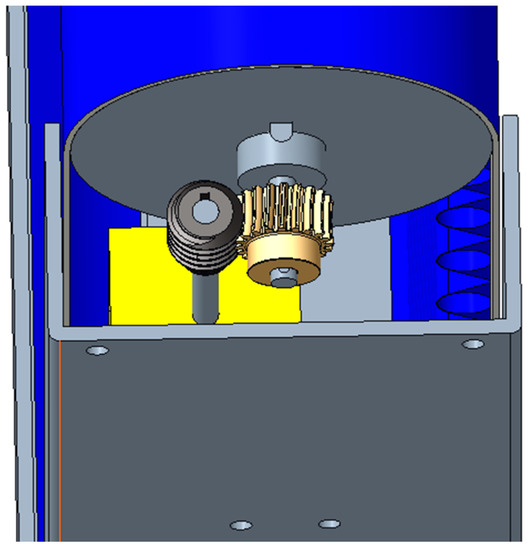
Figure 2.
Possible mechanical design of the rotatable system.
2.2. Numerical Model Description
The numerical model has been previously used to analyze the performance of the presented system for cooling purposes [22], which is an implicit one dimensional finite control volume model [24]. The convective heat transfer between the surfaces and both environments ( and ) are assumed constant, being 8 W/m2·K for the indoor environment and 25 W/m2·K for outdoor surfaces [25]. The melting and solidification processes are implemented through an equivalent heat capacity method [26] with a triangle shaped distribution over temperature [27,28]. The phase change range is 4 K, and hysteresis and subcooling are not considered. Moreover, the temperature of the indoor environment () is set constant to 20 °C [29].
The finite volume model uses uniform discretized spatial step of 1 mm [24] and a time step of 60 s, ensuring mesh independence and consistency of the numerical scheme. A detailed description of the numerical model can be found in de Gracia et al. [22].
2.3. Optimization of Design and Control Parameters
A suitable selection of PCM melting temperature depending on the climatic conditions, building constructive system, and heating demand is mandatory for the correct performance of the system. Moreover, the activation of the system and an appropriate schedule of positioning PCM facing outdoors or indoors plays a crucial role.
Design (phase change PCM temperature) and control (POS[t]) variables have been optimized using a generic optimization program (GenOpt v3.11) [30]. A particle swarm optimization algorithm with constriction coefficient (PSOCC) [31] was used in this study. The algorithm was linked to the finite volume numerical model and was set with the following settings: (i) 20 generations, (ii) 20 particles per generation, and (iii) 2 seeds.
The PSOCC varies these three variables to minimize the heating load ( in J/m2·day):
- (i)
- PCM peak melting temperature () exploring integer values between 8 to 29 °C.
- (ii)
- Hour to start exposure of PCM to solar energy, POS [t] is set to 1 (). Continuous exploration between 0 to 24 h.
- (iii)
- Hour to finish exposure of PCM to solar energy, POS [t] is set to 0 (). Continuous exploration between 0 to 24 h.
It has to be noticed that control was optimized based on the average values of a specific period, meaning that t1 and t0 were set to the same value for all days during the analyzed period. Finally, the daily heating load is computed as shown in Equations (1) and (2). Where is the rate of heating loads per unit area (W/m2) at each time step, is the heat transfer coefficient of the internal surface, is the temperature of the indoor environment, is the temperature of the interior surface, and is the heating load for a specific period between t0 and tend,
2.4. Case Studies
In this study, the novel system has been tested numerically considering the registered weather conditions during November 1st to 10th 2017 (Figure 3) in the experimental set-up of Puigverd de Lleida [32] which is classified as Csa according to Köppen-Geiger [33]. Furthermore, the performance of the dynamic PCM technology has been analyzed in the south wall of the following different constructive systems:
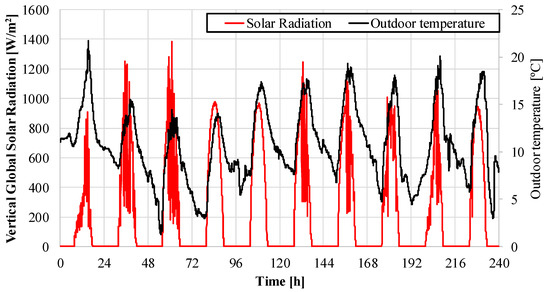
Figure 3.
Weather conditions during the analyzed period.
- Wall 1: Typical Mediterranean constructive system based on two layers of bricks and 5 cm of mineral wool in between.
- Wall 2: Case-600 building prototype from ASHRAE Standard 140-2011 [29].
- Wall 3: Ideal envelope, which is based on a single layer of insulation surrounded by a polymeric sheet with and without PCM.
The three selected morphologies of the building envelope represent different levels of thermal storage capacity and thermal resistance. Without considering the PCM layer, Wall 2 presents a storage capacity of 156.1 kJ/m2·K, while Wall 1 presents more thermal mass and can store 200.7 kJ/m2·K. On the other hand, Wall 3 is analyzed as a case study with minimum storage capacity (10,4 kJ/m2·K) other than the one provided by the use of PCM. Regarding the thermal resistance, Wall 2 presents a thermal transmittance in steady state (U-value) of 0.22 W/m2·K, while U-value of both Wall 1 and Wall 3 is 0.66 W/m2·K. The layer distribution, thickness of each layer, and thermo-physical properties of used materials are given in Table 1 for each tested constructive system.

Table 1.
Thermo-physical properties and constructive systems description (listed from outside to inside).
Furthermore, the specific heat capacity of the PCM layer presents a heat storage capacity of 2,000 J/kg·K outside the phase change range (solid and liquid sensible region), and an enthalpy of fusion of 200 J/g, similar to those available in the market. It might occur that the amount of PCM able to be added in the polymeric sheet is limited, therefore this study will evaluate the influence that the amount of PCM (0%, 25%, 50% 75%, and 100% w/w) has in the performance of the static (conventional system in which PCM is always placed in the layer facing indoors) and the proposed dynamic system.
For the proposed amount of PCM (5.6 kg of PCM/m2), the current design suggests the use of an electrical motor (100 W) for 2 s for changing the position of the PCM layer, which means a daily electrical consumption of 400 J.
3. Results and Discussion
3.1. Thermal Behaviour of Dynamic PCM System
Figure 4 shows the solar radiation and outdoor temperature evolution, and how the variation of the position of PCM layer (0 or 1) affects to the PCM temperature when implemented in ASHRAE envelope (Wall 2). As it can be seen, once the position of the system is set to 1 and PCM is located facing outdoors with respect to the insulation layer, its temperature starts to increase as solar radiation is stored through the melting process of PCM. After the sunny hours, the PCM is set back to its original position (facing indoors with respect to insulation, POS = 0) and discharges the stored heat to the indoor environment. In this period, the PCM layer remains inside the phase change range (21 to 25 °C) being warmer than indoor set point temperature (20 °C), that allows the system not only to be used as a thermal barrier to outdoor conditions, but to provide space heating due to stored solar energy.
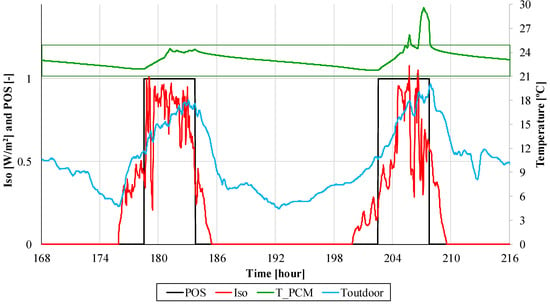
Figure 4.
Evolution of PCM temperature in dynamic system when implemented in the ASHRAE (Wall 2) envelope.
Moreover, as it was previously discussed in the introduction, the current state of the art of passive PCM systems for heating purposes is limited as PCM cannot be melted unless it is directly exposed to solar energy coming from openings or windows. This issue can be clearly seen in Figure 5, which shows the thermal evolution of the polymeric layer (with or without PCM) in case it is implemented in a static or dynamic system. No significant differences were observed between the static system with or without PCM with temperatures below set point (20 °C) almost all the time. On the other hand, the dynamic system is able to charge the PCM partially six days (phase change range between 21 and 25 °C) out of ten, and to fully charge it three days. It is important to highlight, that the control of the system was optimized based on the average results of the ten analyzed days, meaning the optimal decision of positioning PCM facing outdoors and indoors is the same for all the analyzed days, therefore, a daily-based control would even increase the performance. These activations of the PCM result in a dramatic reduction of the heating load coming from the outer environment. Figure 6 presents the evolution of the heating load for static and dynamic systems, showing that the use of PCM does not reduce heating load unless it is implemented in the dynamic technology. When the PCM layer is able to move with respect to the insulation, it provides space heating to indoor environment (negative heating loads), specially during afternoons and night periods. It has to be noticed that since the schedule of operation of the system is optimized to minimize the overall heating load and activations are set at the same time for each day, in some particular days with low solar radiation (first two tested days), the dynamic system can provide extra heating loads in some specific periods.
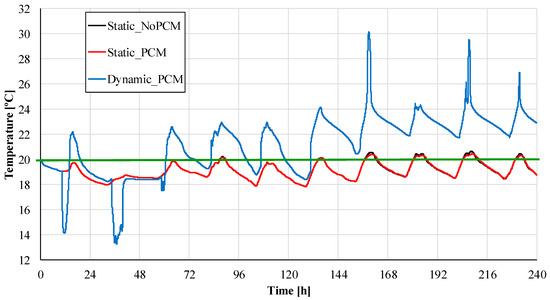
Figure 5.
Evolution of polymeric layer temperature when implemented in the ASHRAE (Wall 2) envelope.
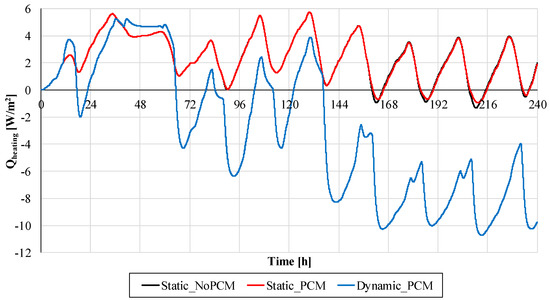
Figure 6.
Evolution of heating load for the different analysed systems when implemented in the ASHRAE (Wall2) envelope.
3.2. Heating Load Reduction by Using Dynamic PCM Wall
Table 2 presents the heating load reduction provided by the dynamic system when implemented into different types of envelopes. The results show reductions higher than 100% in all studied envelopes for the analyzed period, which means that when using the dynamic system, the envelope is able to provide more heat from solar energy than what is transferred to the outdoor environment due to thermal losses. Results also demonstrate that the system performs better when implemented into building walls with low thermal mass, as PCM is more directly exposed to solar radiation and it can also discharge stored solar heat easily to the indoor environment. Table 2 also shows that optimum PCM melting temperature depends on the constructive system in which the dynamic system is implemented, with its melting peak at 21 °C in the case when it is implemented in walls with high thermal mass (Wall 1) and 23 °C in cases with lower thermal mass (Wall 2 and 3).

Table 2.
Heating load reduction by using static and dynamic PCM for each constructive system.
3.3. Parametric Analysis of Amount of PCM
As it was previously stated, the implementation of PCM in the movable layer can be achieved by means of using a polymeric matrix, or other system such as tubes or honeycomb layers. In any case, the addition of PCM will not achieve 100% w/w, as some matrix will be used to hold the PCM and prevent its leakage. Within this context, Table 3 presents how the amount of PCM in the rotatable layer affects the performance of the whole system in terms of energy savings and optimal control strategy (t0 and t1). Results show that the dynamic system is able to provide considerable heating benefits even without using any PCM in the movable layer and just storing solar energy in the polymeric matrix in a sensible form. Thus, this can reduce the heating load by 36% when the dynamic system is implemented in Wall1 and Wall3 construction systems and by more than 50% when implemented into the Wall 2 envelope. Furthermore, the use of any amount of PCM enhances dramatically this effect, as the system achieves heating load reductions higher than 100% when using 50% w/w of PCM in Wall 1 and when using 25% w/w of PCM in Wall 2 and Wall 3 construction systems. That means that with these proportions of PCM, the system provides a positive energy balance, as the amount of solar energy dissipated indoors is higher than heat losses to the outdoor environment.

Table 3.
Sensitivity analysis of PCM amount in heating load and control parameters by using dynamic system for each constructive system.
As expected, the more amount of PCM added in the movable layer, the higher heating benefits that the system can provide. However, this improvement is not always linear, as shown in Figure 7. The system cannot improve benefits when adding more PCM than 50% in the case when the system is implemented in Wall 1, as the high thermal mass of the constructive system also plays an important role. On the other hand, lightweight systems (Wall 3) present a linear relation between thermal benefits and the amount of PCM; numerical results suggest that thicker rotatable layers with PCM could be a good option to even maximize the heating benefits. Thus, this remarks the importance of a proper design of the system depending on the morphology of the building element (roof or wall) in which it will be implemented and the weather conditions under which it will be exposed.
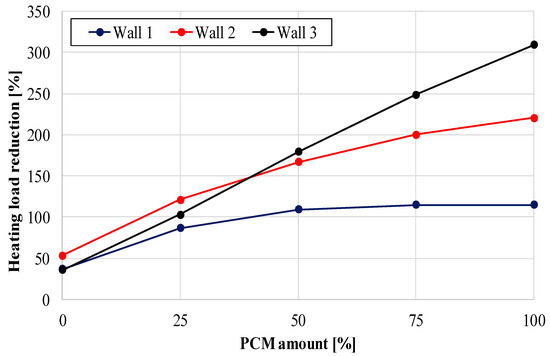
Figure 7.
Heating load reduction in case of different amount of PCM.
4. Conclusions
A numerical proof of concept of a novel PCM heating technology implemented into building walls and/or roofs is given. The system is able to change the position of the PCM layer with respect to the insulation inside the building component. Therefore, the system can locate PCM facing outdoors during sunny hours to maximize solar absorption and the position of the PCM facing indoors to provide space heating when required by the demand. The novel dynamic system has been numerically tested when implemented into three different construction morphologies under Csa weather conditions, providing extraordinary benefits in all of them. Numerical results demonstrate that the system can not only be used as a thermal barrier from the outer environment but can provide active space heating from stored solar energy. Moreover, in case of using movable layers with limited quantity of PCM (25–50% w/w), the system is able to provide positive net energy balance, meaning that it releases indoors more stored solar energy than all the heat losses to the outdoor environment.
The study also highlighted that the performance of the system is highly influenced by certain design key parameters, such as melting temperature and amount of PCM, as well as on control schedule to determine activations during the day. These variables should be examined and optimized for each case, considering constructive system, building use, and weather conditions.
The high potential to reduce energy consumption for space heating applications showed by the numerical results supports the future development of an experimental prototype to quantify the benefits from this technology under relevant environment and evaluate its economic and environmental benefits.
Funding
This work was partially funded by the Ministerio de Ciencia, Innovación y Universidades de España (RTI2018-093849-B-C31). The authors at the University of Lleida would like to thank the Catalan Government for the quality accreditation given to their research group (2017 SGR 1537). GREA is certified agent TECNIO in the category of technology developers from the Government of Catalonia. A.D.G. has received funding from the European Union’s Horizon 2020 research and innovation programme under the Marie Sklodowska-Curie grant agreement No 712949 (TECNIOspring PLUS) and from the Agency for Business Competitiveness of the Government of Catalonia.
Conflicts of Interest
The author declares no conflict of interest.
References
- Omrany, H.; Ghaffarianhoseini, A.; Ghaffarianhoseini, A.; Raahemifar, K.; Tookey, J. Application of passive wall systems for improving the energy efficeing in buildings: A comprehensive review. Renew. Sustain. Energy Rev. 2016, 62, 1252–1269. [Google Scholar] [CrossRef]
- International Energy Agency. Transition to Sustainable Buildings Strategiesand Opportunities to 2050; International Energy Agency: Paris, France, 2013. [Google Scholar]
- Stritih, U.; Tyagi, V.V.; Stropnik, R.; Paksoy, H.; Haghighat, F.; Mastani Joybari, M. Integration of passive PCM technologies for net-zero energy buildings. Sustain. Cities Soc. 2018, 41, 286–295. [Google Scholar] [CrossRef]
- De Gracia, A.; Cabeza, L.F. Phase change materials and thermal energy storage for buildings. Energy Build. 2015, 103, 414–419. [Google Scholar] [CrossRef]
- Navarro, L.; de Gracia, A.; Niall, D.; Castell, A.; Browne, M.; McCormack, S.J.; Griffiths, P.; Cabeza, L.F. Thermal energy storage in building integrated thermal systems: A review. Part 2. Integration as passive system. Renew. Energy 2016, 85, 1334–1356. [Google Scholar] [CrossRef]
- Cabeza, L.F.; Castellón, C.; Nogués, M.; Medrano, M.; Leppers, R.; Zubillaga, O. Use of microencapsulated PCM in concrete walls for energy savings. Energy Build. 2007, 39, 113–119. [Google Scholar] [CrossRef]
- Schossig, P.; Henning, H.-M.; Gschwander, S.; Haussmann, T. Micro-encapsulated phase-change materials integrated into construction materials. Sol. Energy Mater. Sol. Cells 2005, 89, 297–306. [Google Scholar] [CrossRef]
- Kosny, J.; Kossecka, E.; Brzezinski, A.; Tleoubaev, A.; Yarbrough, D. Dynamic thermal performance analysis of fiber insulations containing bio-based phase change materials (PCMs). Energy Build. 2012, 52, 122–131. [Google Scholar] [CrossRef]
- Scalat, S.; Banu, D.; Hawes, D.; Paris, J.; Haghighat, F.; Feldman, D. Full scale thermal testing of latent heat storage in wallboard. Sol. Energy Mater. Sol. Cells 1996, 44, 46–61. [Google Scholar] [CrossRef]
- Zhang, M.; Medina, M.A.; King, J.B. Development of a thermally enhanced frame wall with phase change materials for on-peak air conditioning demand reduction and energy savings in residential buildings. Int. J. Energy Res. 2005, 29, 795–809. [Google Scholar] [CrossRef]
- Kuznik, F.; Virgone, J. Experimental assessment of phase change material for wall building use. Appl. Energy 2009, 86, 2038–2046. [Google Scholar] [CrossRef]
- Castell, A.; Martorell, I.; Medrano, M.; Pérez, G.; Cabeza, L.F. Experimental study of using PCM in brick constructive solutions for passive cooling. Energy Build. 2010, 42, 534–540. [Google Scholar] [CrossRef]
- Saffari, M.; de Gracia, A.; Fernández, C.; Cabeza, L.F. Simulation-based optimization of PCM melting temperatura to improve the energy performence in buildings. Appl. Energy 2017, 202, 420–434. [Google Scholar] [CrossRef]
- Mandilaras, I.; Stamatiadou, M.; Katsourinis, D.; Zannis, G.; Founti, M. Experimental thermal characterisation of a Mediterranean residential building with PCM gypsum board walls. Build. Environ. 2013, 61, 93–103. [Google Scholar] [CrossRef]
- Navarro, L.; de Gracia, A.; Castell, A.; Cabeza, L.F. Thermal behaviour of insulation and phase change materials in buildings with internal heat loads: Experimental study. Energy Effic. 2015, 8, 895–904. [Google Scholar] [CrossRef]
- Marin, P.; Saffari, M.; de Gracia, A.; Zhu, X.; Farid, M.M.; Cabeza, L.F.; Ushak, S. Energy savings due to the use of PCM for relocatable lightweight buildings passive heating and cooling in different weather conditions. Energy Build. 2016, 129, 274–283. [Google Scholar] [CrossRef]
- Stamatiadou, M.; Antonopoulos, K.; Founti, M. Energy savings using floor tiles with phase change materials in a S. European country. In Proceedings of the 11th International Conference on Thermal Energy Storage for Energy Efficiency and Sustainability (Effstock), Stockholm, Sweden, 14–17 June 2009. [Google Scholar]
- Loonen, R.C.; Trčka, M.; Cóstola, D.; Hensen, J.L. Climate adaptive building shells: State-of-the-art and future challenges. Renew. Sustain. Energy Rev. 2013, 25, 483–493. [Google Scholar] [CrossRef]
- Mols, T.; Blumberga, A.; Karklina, I. Evaluation of climate adaptive building shells: Multi-criteria analysis. Energy Procedia 2017, 128, 292–296. [Google Scholar] [CrossRef]
- Lee, C.; Hoes, P.; Cóstola, D.; Hensen, J.L. Assessing the performance potential of climate adaptive greenhouse shells. Energy 2019, 175, 534–545. [Google Scholar] [CrossRef]
- Simko, M.; Krajcik, M.; Sikula, O.; Simko, P.; Kalús, D. Insulation panels for active control of heat transfer in walls operated as space heating or as a thermal barrier: Numerical simulations and experiments. Energy Build. 2018, 158, 135–146. [Google Scholar] [CrossRef]
- De Gracia, A. Dynamic building envelope with PCM for cooling purposes—Proof of concept. Appl. Energy 2019, 235, 1245–1253. [Google Scholar] [CrossRef]
- Barreneche, C.; Fernández, A.I.; Niubó, M.; Chimenos, J.M.; Espiell, F.; Segarra, M.; Solé, C.; Cabeza, L.F. Development and characterization of new shape-stabilized phase change material PCM—Polymer including electrical arc furnace dust EAFD, for acoustic and thermal comfort in buildings. Energy Build. 2013, 61, 210–214. [Google Scholar] [CrossRef]
- Izquierdo-Barrientos, M.A.; Belmonte, J.F.; Rodríguez-Sánchez, D.; Molina, A.E.; Almendros-Ibáñex, J.A. A numerical study of external building walls containing phase change materials PCM. Appl. Therm. Eng. 2012, 47, 73–85. [Google Scholar] [CrossRef]
- Ministerio Fomento. Código Técnico de la Edificación, Documento Básico HE. Ahorro de Energía; Ministerio Fomento: Madrid, Spain, 2013. [Google Scholar]
- Lamberg, P.; Lehtiniemi, R.; Henell, A.M. Numerical and experimental investigation of melting and freezing processes in phase change material storage. Int. J. Therm. Sci. 2004, 43, 277–287. [Google Scholar] [CrossRef]
- Farid, M.M. A new approach in the calculation of heat transfer with phase change. In Proceedings of the 9th International Congress on Energy and Environment, Miami, FL, USA, 13–15 December 1989; pp. 1–19. [Google Scholar]
- De Gracia, A.; Navarro, L.; Castell, A.; Cabeza, L.F. Numerical study on the thermal performance of a ventilated facade with PCM. Appl. Therm. Eng. 2013, 61, 372–380. [Google Scholar] [CrossRef]
- ASHRAE. ANSI/ASHRAE Standard 55-2013. Thermal Environmental Conditions for Human Occupancy; ASHRAE: Atlanta, GA, USA, 2013. [Google Scholar]
- Wetter, M. GenOpt—A generic optimization program. In Proceedings of the Seventh International IBPSA Conference, Rio de Janeiro, Brazil, 13–15 August 2001; pp. 601–608. [Google Scholar]
- Kennedy, J.; Eberhart, R. Particle swarm optimization. Proc. IEEE Int. Conf. Neural Netw. 1995, 4, 1942–1948. [Google Scholar] [CrossRef]
- De Gracia, A.; Navarro, L.; Coma, J.; Serrano, S.; Romaní, J.; Pérez, G.; Cabeza, L.F. Experimental set-up for testing active and passive systems for energy savings in buildings—Lessons learnt. Renew. Sustain. Energy Rev. 2018, 82, 1014–1026. [Google Scholar] [CrossRef]
- Kottek, M.; Grieser, J.; Beck, C.; Rudolf, B.; Rubel, F. World map of the Köppen-Geiger climate classification. Meteorologische Zeitschrift 2006, 15, 259–263. [Google Scholar] [CrossRef]
© 2019 by the author. Licensee MDPI, Basel, Switzerland. This article is an open access article distributed under the terms and conditions of the Creative Commons Attribution (CC BY) license (http://creativecommons.org/licenses/by/4.0/).